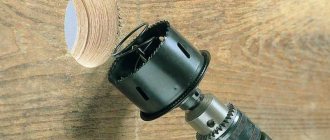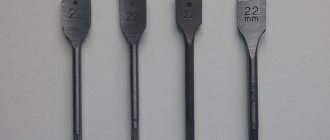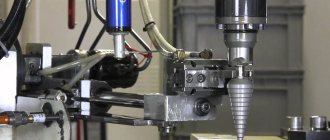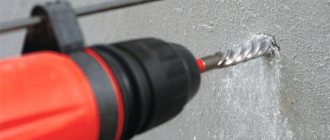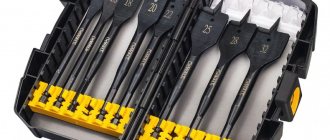A wide range of different devices used for drilling holes is presented to the consumer's attention. Feather drills are designed for working with wood.
These products are used by both carpenters and professional furniture assemblers, as well as home craftsmen. Information about the design features, technical characteristics and sizes of pen drills for wood is contained in this article.
Acquaintance
A pin drill is a special cutting tool designed for drilling various holes in wood. They can work with both natural wood and chipboards and MDF products.
The master can also use such an expensive tool as a disk cutter. However, judging by consumer reviews, such use cannot be considered sufficiently justified. It is more advisable to purchase a feather drill for wood. Compared to a disk cutter, this tool is much cheaper, and moreover, it is no less effective. You can work with it using either an electric drill or a regular screwdriver.
Advantages of a feather drill
There are a very large number of different types of drilling machines and devices for processing various materials. But for wood, a feather drill is better suited than others. Experts say the most important advantage is the cost of the drill, since it is one of the cheapest types.
In terms of cost and efficiency, a feather drill for wood is compared with a device that bears the name of Fostner. Sometimes these two types are confused by calling one and the other cork. The latest drills have become widespread in the manufacture of furniture, since it is really better than other types for creating blind holes.
Fostner drill.
Because the former cannot be used in this capacity due to the tip. In addition, it is worth considering that the working diameter of the drill and other devices are different. There is an advantage on the side of the first unit, which has a wider range of working diameters.
It is important to remember that with the help of the first devices, mostly rough work is performed.
Since its accuracy suffers, which is undoubtedly the main drawback, a hole with a diameter of 40 and 60 millimeters after drilling sometimes has to be processed and additionally sanded, since the cutters passing through the walls of the hole leave fluffy wood residues on them. This affects the quality of the holes and their appearance, so when using a pen it is better to always have sandpaper on hand.
One important advantage is the ability to sharpen the nib yourself, although it is noteworthy that the point loses its sharpness too quickly. In addition, a quality woodworking pen can be used not only for drilling wood, but also for drilling thin sheets of metal. The maximum diameter is from 40 to 60 millimeters.
Tool structure
The feather drill has a simple design. The tool consists of two parts:
- Working. It is a flat blade equipped with a special rigid protrusion in the center. During the drilling process, it performs alignment. The working part is also equipped with two cutting blades, which are located on both sides of the protrusion. The sharpened cutting edge extends from the tip of the protrusion to the edge of the working part of the drill. The tool has a right- or left-hand sharpening inclination. These attachments perform drilling in one direction. For such a cutter, a sharpening angle of 75-90 degrees is provided. There are also double-sided nozzles, the cutting angle of which is 120-135 degrees.
- Tail. The cross section has a hexagonal shape, thanks to which the drill is securely fixed in the chucks of a drill and screwdriver. In addition, the attachment can be installed in magnetic adapters and extensions.
Main characteristics
When using pen drills for wood, it is advisable to know how they differ from other types of cutting tools and what advantages they have.
Comparison with other types of instruments
Like metal drills, tools designed for woodworking are available in various designs and, accordingly, differ from each other in characteristics and functionality. When choosing such tools, you should have an idea of the advantages and disadvantages they have.
Table 1. Comparison of different types of wood drills
Feather drills, as can be seen from the table presented, have a number of advantages when compared with other types of tools. Meanwhile, a pen-type tool is not recommended for making large-diameter holes (more than 60 mm), since their edges may turn out torn. For such purposes, it is better to use core drills, which are made in the shape of a metal cup with cutting teeth located on its end part.
A pen with a threaded tip is more suitable for working on a machine: it drills faster, but the hole may end up oval-shaped if the part is not secured with clamps
Due to the low cost of feather drills for wood, any home craftsman can purchase a set of them. Having such a set in your home workshop makes it easy and quick to select a tool for drilling holes of different diameters.
Design Features
The tip drill has a very simple design, the elements of which are the working and tail parts.
Feather drill design
The working part is a flat blade, in the center of which there is a sharp protrusion used to center the hole being made. On the working part of the pen drills there are two cutting blades located on either side of the central protrusion. Each of these blades starts from the tip of the central protrusion and reaches one of the edges of the working part. The tilt of sharpening the blades of feather drills for wood, if you look at their working part in cross section, is done to the right. When making drills of this type, manufacturers adhere to certain ratios between the thickness and width of the cutting part.
Table 2. The ratio of the thickness and width of the cutting element of the drill
The tail part is made in the shape of a hexagon. This cross-sectional shape allows not only to securely fix the tool in the chucks of drills and screwdrivers, but also to use magnetic adapters and extensions for these purposes.
The simplicity of the design, which distinguishes drills related to pen drills, the absence of spiral grooves, ribbons and other complex elements, are not indicators of the low efficiency of this tool.
Spade drills with two scorers enter the wood more smoothly and leave fewer burrs along the edges of the holes.
Recommendations for selection When
choosing a spade drill designed for woodworking, you should pay attention to several parameters:
- correctness of shape (wood drill feathers located on the right and left sides of the central protrusion must be symmetrical and identical in their linear dimensions);
- degree of sharpness of the cutting part (sharpening of new pen drills must be carried out in the factory and meet standard requirements);
- absence of visible defects (if the surface of a new drill contains visible defects of various types, this is a clear indicator of the low quality of such a product, most likely produced in artisanal conditions);
- color (by the color of the metal you can determine the types of additional processing to which the finished product has been subjected).
Table 3. Influence of manufacturing technology on the color of the drill bit
Color
During the manufacturing process of drills for tools, finishing is provided. Its task is to give the product increased strength. Several processing options are used in production. Each of them gives the product certain performance characteristics. During the process, a coating is applied to the surface of the drill, the color of which can be used to judge the performance properties of the tool:
- Black attachments have increased durability. In production, superheated steam is used for their finishing.
- The drills are golden yellow in color and have no metallic stress.
- Bright golden nozzles are treated with titanium nitride, thereby increasing the service life of the products.
- Tools that have not undergone finishing are gray in color.
It is recommended to consider this aspect when purchasing a set of feather drill bits for wood.
Types of drills and coatings
Feather drills are divided into:
- One-sided. Cutting angle – 75-90o.
- Double-sided. Cutting angle – 120-135o.
Nozzles can be reinforced with certain coatings:
- titanium nitride (the most expensive option; resource increases by more than 5 times, characteristic bright golden hue);
- oxide film (protecting the nozzle from corrosion and overheating);
- steam treatment (increases strength; the metal becomes darker).
The tool without additional processing has the usual gray color of steel.
What should you pay attention to when purchasing?
For those who want to purchase a feather drill, experienced craftsmen advise paying attention to the following nuances:
- The tool must have a symmetrical configuration.
- Equipped with smooth cutting elements. The latter is a clear indicator that the cutting attachment is a factory one and not a homemade model. Feather drills and their cutting parts have a high degree of sharpness and meet the standards only if they are manufactured exclusively in the factory.
- During a superficial inspection, the buyer must make sure that the surface of the drill is free of any defects in the form of chips or irregularities.
Advantages
The advantages of feather cutting attachments include:
- Low cost. The price of the instrument varies between 50-120 rubles. The cost will depend on the finishing technology used in the manufacture of the nozzle.
- The set of pen drills for wood is equipped with cutting products, the diameters of which vary from 5 to 60 mm.
- Thanks to the design of the tool, it can be extended by 300 mm using a special attachment for this purpose.
- The drill is easy to use.
- If its cutting part wears out, a craftsman can always sharpen it at home. The exception is when the feather drills are too worn.
Features of use
To increase the efficiency of using feather drills for wood and obtain maximum effect, you should follow simple rules for their use:
- wood is drilled at low drill speeds: 300-400 rpm;
- It is advisable to use a power tool with the ability to adjust power;
- mark future holes;
- Periodically remove accumulated chips.
You can choose the right wood drill bits for you in the online store. We offer tools manufactured at our company's production facilities in China. Our products have been awarded quality certificates. A guarantee is given for each product. You can pick up the ordered equipment from a warehouse in Moscow, or use the services of transport companies. Please check all the details on payment terms, guarantees and delivery in the appropriate section of the website.
Flaws
Despite all the strengths of pen nozzles for woodworking, they have one single drawback. It lies in the fact that this tool has a limited cutting diameter, which does not exceed 6 cm. As a result, only pointed end cutters take part in the drilling process. In this case, the rounded sides of the drill come into contact with the edges of the groove, on which wood fibers are formed. As a result, the surfaces of the holes are rough and not neat enough. Judging by the few reviews, these wood cutting bits become dull very quickly and require frequent re-sharpening.
Spade drill for wood: dimensions, photos, selection and sharpening
The wood spindle drill is very popular among carpentry craftsmen due to its high performance, in which it is unlikely to be compared with standard twist drills for a similar purpose. Drilling pens do an excellent job of forming holes with a diameter of 5 to 60 mm, not only when working on wood, but also when processing other materials (chipboard, MDF, plastic, plasterboard, etc.). As for the cleanliness of the cut, it is not ideal here, so perka is in most cases used to perform rough processes. Feather drills have an elongated rod body with a cutting tip and a hex shank.
A carpentry device with a central point and a pair of incisors branching off from it received its name due to the special shape of the working part, made in the form of a feather. Spade drills come in both single-sided and double-sided, and cut in one or two directions, respectively. A sample with a one-sided cutter has a cutting angle of 75-90°, while for a double-sided drill this parameter is 120-135°.
Advantages and disadvantages
One of the main advantages of feather drills is their affordable price. If we compare them with cylinder drills, then the pen models have a large range of working areas, while the cost of such samples is several times less. The length of the tool is 15 cm, but the hole can be deepened by 30 mm by using a special extension.
The wood tip drill has a simple configuration, thanks to which it can be sharpened without any problems both on professional equipment and manually, and you do not need a special expensive sharpener, but a regular file will be enough. In practice, craftsmen use such drills quite widely, drilling with them not only wooden material, but also thin sheet metal. The hexagonal shank of the product allows you to tightly fix the drill in the power tool chuck, completely eliminating its rotation.
Along with the advantages, feather drills also have disadvantages, and first of all this concerns the limitation of the cutting diameter, since the maximum groove diameter here will be no more than 60 mm. The drilling process in this case is carried out exclusively with pointed end cutters, while the rounded sides of the tool, when in contact with the edges of the groove, leave small wood fibers on them. Because of this feature, the surface of the hole becomes rough and takes on a not very neat appearance. Another disadvantage of the perka drill is that the tool quickly becomes dull and requires re-sharpening.
Dimensions
Depending on the nature of the work, craftsmen purchase individual copies or a complete set of feathers, which usually includes the most popular nozzles of the following diameters: 25 mm, 35 mm, 40 mm, 50 mm and 60 mm. It is these diameters of joinery that will allow you to cope with standard tasks when forming various holes. If you need to cut a groove with a diameter of more than 60 mm, it is better not to purchase feather drills, as they will not be able to cover a large area of the material and the drilling will not be correct.
Operating rules
To ensure that the drill bit does not become deformed during operation and that the work is completed correctly, it is necessary to follow the basic rules for its use. Before starting drilling, craftsmen recommend marking the place where the hole will be formed and using a core to make a small indentation at a given point. Whenever possible, when working with pen-shaped drills, it is better to use a drill with variable speed control. The thing is that in this case the diameter of the pen is directly dependent on the cutting speed: the larger the size of the cutter, the lower the shaft rotation speed should be, and vice versa. If you neglect this rule, you may encounter an unpleasant moment when, at high speed, rapid wear of the cutters will be provoked or the drill will simply break.
If you need to drill deep holes, initially purchase a special extension. Such an auxiliary device, installed on wood drill bits, is equipped with a locking element, which is clamped using a 3 mm hexagon, making the cutter itself and its extension turn into a single piece.
To correctly outline the contour of the groove at the beginning of drilling, set the minimum rotation mode of the drill shaft; for this, it is recommended to use an adjustable power tool. The feather drill should be installed on the surface of the workpiece strictly perpendicularly, while moderate pressure is applied to it. Please note that due to the design features of the pen, during the drilling process, sawdust is not thrown upward, as is the case with Forstner drills, so do not forget to periodically stop work and remove the chips from the groove.
Selection rules
All companies that produce carpentry tools produce feather drills, so to select a quality sample, do not be lazy to familiarize yourself with the following product parameters:
- configuration - must be symmetrical;
- cutting elements must be smooth, which indicates the decent quality of the factory model;
- the absence of any defects on the drills is mandatory, since chips and all kinds of irregularities are more likely to be characteristic of handicraft products.
In addition to the signs listed above, pay attention to the color of the pen drill, because it can tell a lot about the quality of the metal. If the cutting element in front of you is steel-colored with a gray tint, then it did not lend itself to additional processing that improves the quality of the drill. Dark metal indicates that the manufacturers strengthened the product with steam, thereby increasing the strength of the nozzle.
If the drill is produced using a special technology that involves removing material by internal pressure, the metal will acquire a golden color. The highest quality factory drills have a bright golden color, which is typical for products coated with a layer of titanium nitride. This coating significantly increases the service life of the tool by enhancing its strength characteristics, which means that with its help you can drill grooves longer, and you will need a mandrel for feather drills much less often.
Properly sharpening the tool
The feather drill is the easiest to maintain, and you can sharpen it without any problems with your own hands at home, and this can be done using a flat file. If you have a sharpening machine, the process will be even easier. Before sharpening a dull pen, carefully inspect the new tool, which is good for checking the shape of the incisors when editing them. Pay special attention to the tip - it is turned exclusively in the center. Even the slightest deviation relative to the axis will negatively affect the drilling progress and the wood will not be processed properly.
If there is significant deformation of the working area of the tool, there is no point in restoring it, since the efforts made are not worth the result, which is unlikely to be ideal, and the cost of new joinery allows you to change it as soon as necessary. In the video you can view the option of sharpening a feather drill and apply it in practice.
derevo-s.ru
How to use the nozzle?
After purchasing a set of feather drills, you need to select a nozzle of the desired diameter from the package. It is recommended to use this cutting tool following the step-by-step instructions:
- Before drilling a hole in a wooden surface, it must be marked. The mark is applied at the point where the hole will be.
- Experienced craftsmen recommend working with these drills using a drill that has a power regulator. It is desirable that the power tool used can perform 200-500 revolutions. If it is necessary to cut a hole of a larger diameter, the number of turns should be small. Judging by consumer reviews, a 50 mm wood drill bit will cope with its task much more effectively at low speeds. As the diameter decreases, the speed increases accordingly.
- To make a deep hole, it is recommended to equip the drill chuck with a special adapter. In the event that it is necessary to drill to a small depth, the master can immediately fix the cutting attachment in the power tool.
- Bring the power tool with the attachment to the place where you will be drilling. The drill must be positioned perpendicular to the marking.
- Start working, gradually increasing the speed. It is recommended to periodically remove the drill from the hole. This requirement is due to the fact that as the wood goes deeper, chips accumulate. By removing the drill, the master thus creates an opening for wood waste to exit.
- The work is considered completed if the cutting tool has gone deep to the mark required by the master.
How to sharpen a tool?
Judging by reviews from owners, sharpening feather cutting tools is not difficult.
To work, you will need a diamond wheel mounted on a sharpening machine. If such equipment is not available, the home craftsman can use the quality rule. The sharpening procedure will be easy and quick if you follow the following sequence:
- Prepare a previously unused cutting attachment. It will be used as a sample.
- During sharpening, you need to periodically check the cutting attachment being processed with the geometric parameters of an unworn new tool.
When aiming the cutting edges of a pen drill, it is recommended to be as careful as possible. The main thing is that after sharpening the central protrusion of the tool is not damaged.
According to numerous reviews from experienced craftsmen, it is not always advisable to sharpen such products. Very worn feather drills with heavily ground cutting parts are considered waste material. Since such a tool is not very expensive, it is better to immediately purchase a new drill than to waste time and “plant” the diamond wheel.
Selection rules
Finding a high-quality nozzle at an affordable price is not so difficult. If we are talking about trusted companies, such as Bosch, Hitachi, then with a high degree of probability the product is of high quality and reliable. To determine the quality of drills from lesser-known brands, there are several rules that can be easily checked by visual inspection:
- Geometric dimensions. The cutting edges must be symmetrical to each other and be the same size.
- Quality of sharpening of cutting edges. It is checked by touching it with your finger, similar to checking the sharpness of the blade of a kitchen knife.
- The quality of the nozzle. Any irregularities in the working or tail part should alert you. Reliable products have an almost perfect sheen.
- Metal color. An important parameter to pay attention to first is:
Gray steel is highly likely to be completely untreated.
Black - the metal is calcined with steam. This treatment increases the strength and wear resistance of the nozzle.
Golden – internal stress has been removed from the metal. This significantly increases strength.
Bright golden – the drill is coated with a thin layer of titanium nitride. It will last a long time and will cope with the toughest wood.


